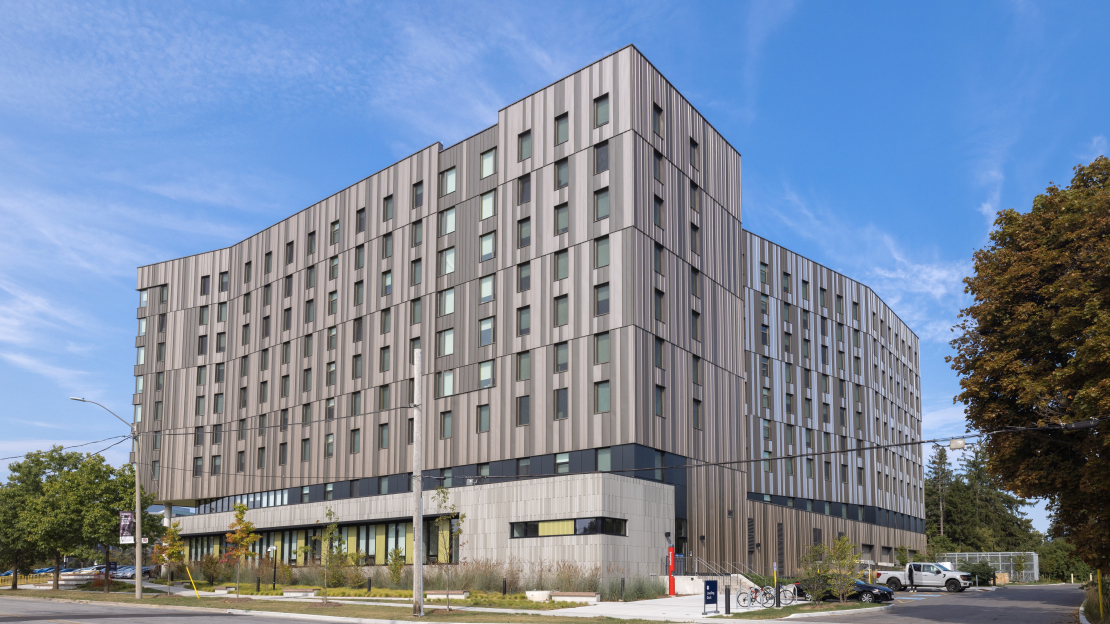Harmony Commons on the campus of the University of Toronto Scarborough (UTSC) has only been open for a little more than a year, but it’s already turning heads for its combination of design and comfortable living spaces.
Now it can add largest passive certified building in Canada—and largest passive house dormitory in the world—to its impressive resumé.
The building received its passive house certification from the Passive House Institute during a ceremony held at UTSC on Sept. 18.
“This is an example to the world of what Canada is doing in high-performance buildings,” says Chris Ballard, president and CEO of Passive House Canada.
“It’s a beacon to institutions and governments around the world that passive house buildings on this scale are doable.”
Passive house is a building standard known for its exceptional energy efficiency, especially when it comes to heating and cooling compared to conventional buildings.
They achieve this through an airtight and well-insulated envelope that prevents heat from escaping. These buildings can consume up to 90 per cent less energy compared to a conventional building.
“The responsibility of sustainability falls on everybody,” says U of T Scarborough CAO Andrew Arifuzzaman, who first learned about passive house design more than 10 years ago.

“We have expertise in building technologies and systems, but if we’re putting up conventional buildings and not driving innovation, then we’re falling short. It became clear that this type of building concept made sense and aligned closely with our values.”
The first group of students moved into the nine-storey, 746-bed residence in September 2023, marking the first dormitory-style residence at U of T Scarborough. In keeping with passive house standards, Harmony Commons is well-ventilated and improved air flow compared to conventional buildings, and the improved air quality is meant to help with sleeping and studying.
A key innovation of the building is that heat is captured from various systems, such as exhaust air from kitchens and showers, and is reused to heat different spaces throughout the building. In fact, heat from every shower taken in the residence is recycled to help warm the building.
The building is so energy efficient that the energy it uses to make more than 3,000 meals each day, across dorms and a large dining hall, is less than what two average households use to make food in a day.
Harmony Commons, which was designed by Handel Architects, is also fully electric. Since no fossil fuels are burned in heating and cooling the building, it has extremely low carbon emissions.
Patricia Escobar, manager of sustainability at U of T Scarborough, notes that typical buildings in Toronto rely on fossil-fuel-based heating systems, but Harmony Commons reduces the amount of heat needed to be generated in the first place.
“This results in significantly fewer greenhouse gas emissions, which supports our goal of becoming a climate positive campus,” she says.
While passive house certification is mostly attempted for small-scale buildings, applying the concepts to a building as large and complex as a dormitory-style residence came with a unique set of challenges and opportunities. Arifuzzaman says that Harmony Commons “de-risked” many of the unknowns associated with building a large-scale passive house building for architects, developers, builders and government.
“It shows the industry that this type of project can be done in this market and at this scale. It proves that passive house is an attainable standard for future large-scale developments,” he says.
He adds it also allowed many local people working in the trades to be trained in new construction methods for high-performance, sustainable buildings.
“This was a great opportunity to realize that you can contribute to reducing global climate change impact and still live a great quality of life,” he says.
Featured image: U of T Scarborough’s residence building Harmony Commons is the largest passive house-certified building in Canada and the largest passive house dormitory in the world. (UTSC/Don Campbell)











